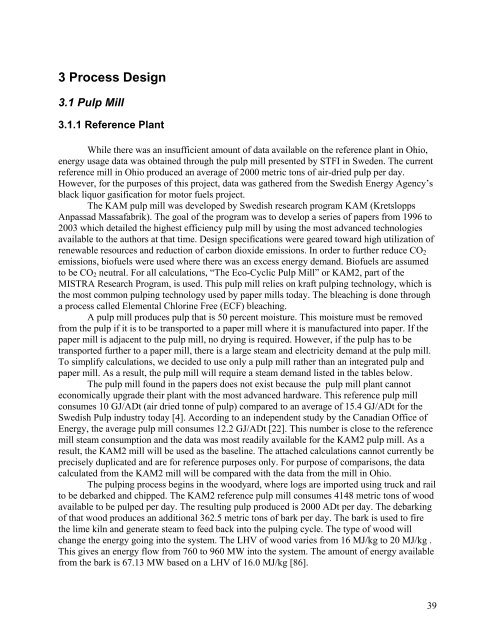Novel Design of an Integrated Pulp Mill Biorefinery for the ...
Novel Design of an Integrated Pulp Mill Biorefinery for the ...
Novel Design of an Integrated Pulp Mill Biorefinery for the ...
You also want an ePaper? Increase the reach of your titles
YUMPU automatically turns print PDFs into web optimized ePapers that Google loves.
3 Process <strong>Design</strong><br />
3.1 <strong>Pulp</strong> <strong>Mill</strong><br />
3.1.1 Reference Pl<strong>an</strong>t<br />
While <strong>the</strong>re was <strong>an</strong> insufficient amount <strong>of</strong> data available on <strong>the</strong> reference pl<strong>an</strong>t in Ohio,<br />
energy usage data was obtained through <strong>the</strong> pulp mill presented by STFI in Sweden. The current<br />
reference mill in Ohio produced <strong>an</strong> average <strong>of</strong> 2000 metric tons <strong>of</strong> air-dried pulp per day.<br />
However, <strong>for</strong> <strong>the</strong> purposes <strong>of</strong> this project, data was ga<strong>the</strong>red from <strong>the</strong> Swedish Energy Agency’s<br />
black liquor gasification <strong>for</strong> motor fuels project.<br />
The KAM pulp mill was developed by Swedish research program KAM (Kretslopps<br />
Anpassad Massafabrik). The goal <strong>of</strong> <strong>the</strong> program was to develop a series <strong>of</strong> papers from 1996 to<br />
2003 which detailed <strong>the</strong> highest efficiency pulp mill by using <strong>the</strong> most adv<strong>an</strong>ced technologies<br />
available to <strong>the</strong> authors at that time. <strong>Design</strong> specifications were geared toward high utilization <strong>of</strong><br />
renewable resources <strong>an</strong>d reduction <strong>of</strong> carbon dioxide emissions. In order to fur<strong>the</strong>r reduce CO2<br />
emissions, bi<strong>of</strong>uels were used where <strong>the</strong>re was <strong>an</strong> excess energy dem<strong>an</strong>d. Bi<strong>of</strong>uels are assumed<br />
to be CO2 neutral. For all calculations, “The Eco-Cyclic <strong>Pulp</strong> <strong>Mill</strong>” or KAM2, part <strong>of</strong> <strong>the</strong><br />
MISTRA Research Program, is used. This pulp mill relies on kraft pulping technology, which is<br />
<strong>the</strong> most common pulping technology used by paper mills today. The bleaching is done through<br />
a process called Elemental Chlorine Free (ECF) bleaching.<br />
A pulp mill produces pulp that is 50 percent moisture. This moisture must be removed<br />
from <strong>the</strong> pulp if it is to be tr<strong>an</strong>sported to a paper mill where it is m<strong>an</strong>ufactured into paper. If <strong>the</strong><br />
paper mill is adjacent to <strong>the</strong> pulp mill, no drying is required. However, if <strong>the</strong> pulp has to be<br />
tr<strong>an</strong>sported fur<strong>the</strong>r to a paper mill, <strong>the</strong>re is a large steam <strong>an</strong>d electricity dem<strong>an</strong>d at <strong>the</strong> pulp mill.<br />
To simplify calculations, we decided to use only a pulp mill ra<strong>the</strong>r th<strong>an</strong> <strong>an</strong> integrated pulp <strong>an</strong>d<br />
paper mill. As a result, <strong>the</strong> pulp mill will require a steam dem<strong>an</strong>d listed in <strong>the</strong> tables below.<br />
The pulp mill found in <strong>the</strong> papers does not exist because <strong>the</strong> pulp mill pl<strong>an</strong>t c<strong>an</strong>not<br />
economically upgrade <strong>the</strong>ir pl<strong>an</strong>t with <strong>the</strong> most adv<strong>an</strong>ced hardware. This reference pulp mill<br />
consumes 10 GJ/ADt (air dried tonne <strong>of</strong> pulp) compared to <strong>an</strong> average <strong>of</strong> 15.4 GJ/ADt <strong>for</strong> <strong>the</strong><br />
Swedish <strong>Pulp</strong> industry today [4]. According to <strong>an</strong> independent study by <strong>the</strong> C<strong>an</strong>adi<strong>an</strong> Office <strong>of</strong><br />
Energy, <strong>the</strong> average pulp mill consumes 12.2 GJ/ADt [22]. This number is close to <strong>the</strong> reference<br />
mill steam consumption <strong>an</strong>d <strong>the</strong> data was most readily available <strong>for</strong> <strong>the</strong> KAM2 pulp mill. As a<br />
result, <strong>the</strong> KAM2 mill will be used as <strong>the</strong> baseline. The attached calculations c<strong>an</strong>not currently be<br />
precisely duplicated <strong>an</strong>d are <strong>for</strong> reference purposes only. For purpose <strong>of</strong> comparisons, <strong>the</strong> data<br />
calculated from <strong>the</strong> KAM2 mill will be compared with <strong>the</strong> data from <strong>the</strong> mill in Ohio.<br />
The pulping process begins in <strong>the</strong> woodyard, where logs are imported using truck <strong>an</strong>d rail<br />
to be debarked <strong>an</strong>d chipped. The KAM2 reference pulp mill consumes 4148 metric tons <strong>of</strong> wood<br />
available to be pulped per day. The resulting pulp produced is 2000 ADt per day. The debarking<br />
<strong>of</strong> that wood produces <strong>an</strong> additional 362.5 metric tons <strong>of</strong> bark per day. The bark is used to fire<br />
<strong>the</strong> lime kiln <strong>an</strong>d generate steam to feed back into <strong>the</strong> pulping cycle. The type <strong>of</strong> wood will<br />
ch<strong>an</strong>ge <strong>the</strong> energy going into <strong>the</strong> system. The LHV <strong>of</strong> wood varies from 16 MJ/kg to 20 MJ/kg .<br />
This gives <strong>an</strong> energy flow from 760 to 960 MW into <strong>the</strong> system. The amount <strong>of</strong> energy available<br />
from <strong>the</strong> bark is 67.13 MW based on a LHV <strong>of</strong> 16.0 MJ/kg [86].<br />
39

















